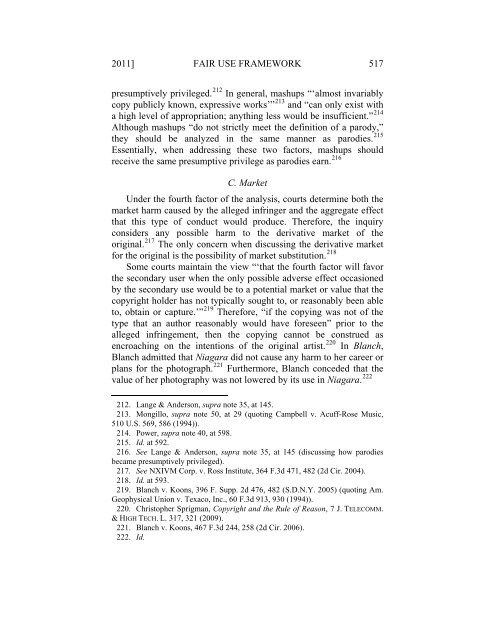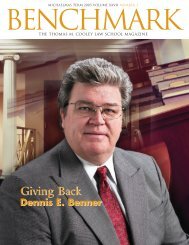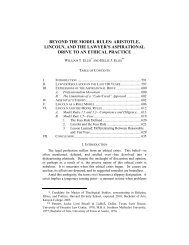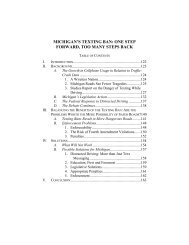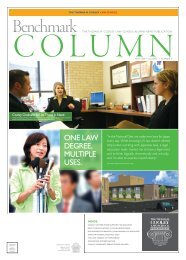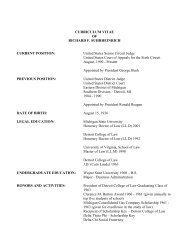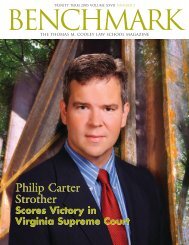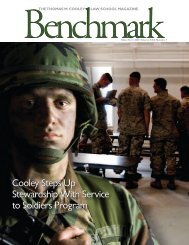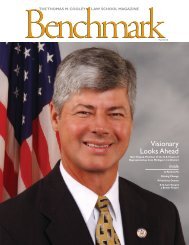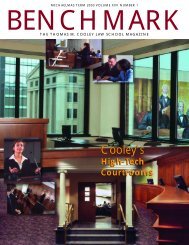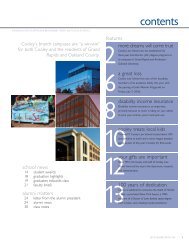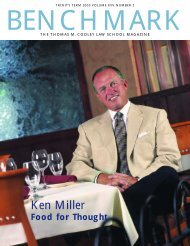Blanch It, Mix It, Mash It - Thomas M. Cooley Law School
Blanch It, Mix It, Mash It - Thomas M. Cooley Law School
Blanch It, Mix It, Mash It - Thomas M. Cooley Law School
Create successful ePaper yourself
Turn your PDF publications into a flip-book with our unique Google optimized e-Paper software.
2011] FAIR USE FRAMEWORK 517<br />
presumptively privileged. 212 In general, mashups “‘almost invariably<br />
copy publicly known, expressive works’” 213 and “can only exist with<br />
a high level of appropriation; anything less would be insufficient.” 214<br />
Although mashups “do not strictly meet the definition of a parody,”<br />
they should be analyzed in the same manner as parodies. 215<br />
Essentially, when addressing these two factors, mashups should<br />
receive the same presumptive privilege as parodies earn. 216<br />
C. Market<br />
Under the fourth factor of the analysis, courts determine both the<br />
market harm caused by the alleged infringer and the aggregate effect<br />
that this type of conduct would produce. Therefore, the inquiry<br />
considers any possible harm to the derivative market of the<br />
original. 217 The only concern when discussing the derivative market<br />
for the original is the possibility of market substitution. 218<br />
Some courts maintain the view “‘that the fourth factor will favor<br />
the secondary user when the only possible adverse effect occasioned<br />
by the secondary use would be to a potential market or value that the<br />
copyright holder has not typically sought to, or reasonably been able<br />
to, obtain or capture.’” 219 Therefore, “if the copying was not of the<br />
type that an author reasonably would have foreseen” prior to the<br />
alleged infringement, then the copying cannot be construed as<br />
encroaching on the intentions of the original artist. 220 In <strong>Blanch</strong>,<br />
<strong>Blanch</strong> admitted that Niagara did not cause any harm to her career or<br />
plans for the photograph. 221 Furthermore, <strong>Blanch</strong> conceded that the<br />
value of her photography was not lowered by its use in Niagara. 222<br />
212. Lange & Anderson, supra note 35, at 145.<br />
213. Mongillo, supra note 50, at 29 (quoting Campbell v. Acuff-Rose Music,<br />
510 U.S. 569, 586 (1994)).<br />
214. Power, supra note 40, at 598.<br />
215. Id. at 592.<br />
216. See Lange & Anderson, supra note 35, at 145 (discussing how parodies<br />
became presumptively privileged).<br />
217. See NXIVM Corp. v. Ross Institute, 364 F.3d 471, 482 (2d Cir. 2004).<br />
218. Id. at 593.<br />
219. <strong>Blanch</strong> v. Koons, 396 F. Supp. 2d 476, 482 (S.D.N.Y. 2005) (quoting Am.<br />
Geophysical Union v. Texaco, Inc., 60 F.3d 913, 930 (1994)).<br />
220. Christopher Sprigman, Copyright and the Rule of Reason, 7 J. TELECOMM.<br />
& HIGH TECH. L. 317, 321 (2009).<br />
221. <strong>Blanch</strong> v. Koons, 467 F.3d 244, 258 (2d Cir. 2006).<br />
222. Id.


